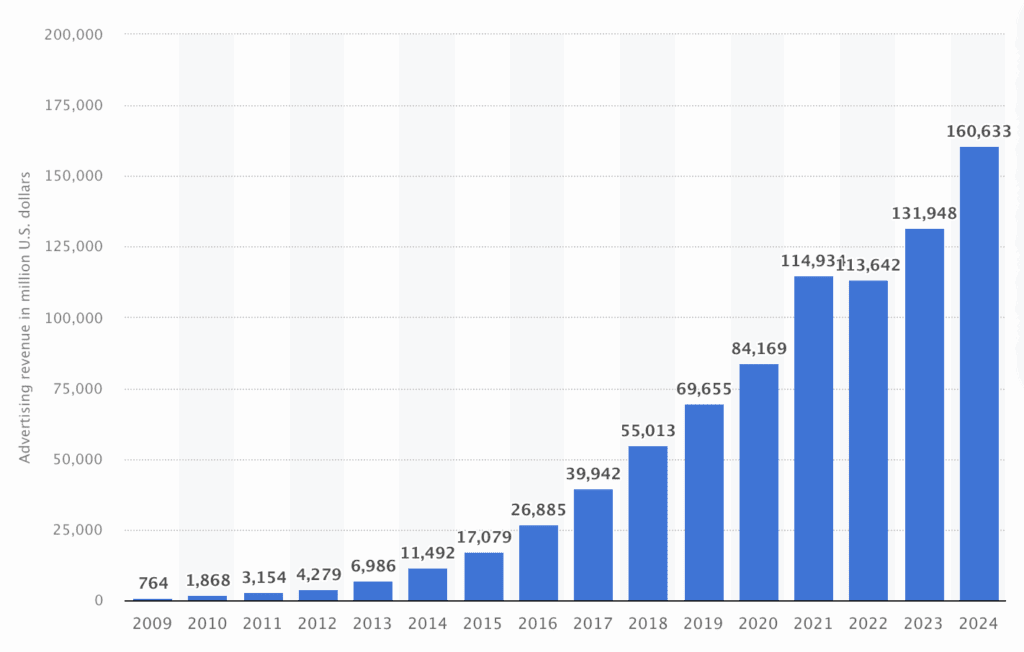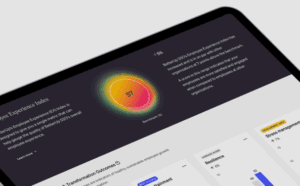Home / Blog / Digital Marketing Prediction for 2026: Audiences Are Everything
digital marketing
Digital Marketing Prediction for 2026: Audiences Are Everything
Published: October 09, 2025
Share on LinkedIn Share on Twitter Share on Facebook Click to print Click to copy url

Contents Overview
For the first time in two decades, marketing efficiency is on the verge of a historic breakthrough. Across every major digital channel — search, social, and emerging AI interfaces — the same pattern is emerging: audience-based targeting is replacing keyword-based discovery, unlocking what could become the lowest cost-per-acquisition (CPA) and cost-per-lead (CPL) rates the industry has ever seen.
This isn’t speculation. The signals are already visible in the data.
- Meta’s ad revenue surged from $134.9 billion in 2023 to $164.5 billion in 2024 (Statista), despite a tightening global ad market. The reason? AI-driven audience modeling and predictive targeting increased efficiency per impression.
- Google’s AI Max, released in May 2025, represents the same paradigm shift for search campaigns — advertisers now upload creative assets and conversion data while Google’s models automatically predict which users to reach. Early pilots show conversion lifts of 14–27% without additional spend.
- In organic search, Google’s AI Mode and keywordless targeting systems (SEO Sherpa, 2025) are proving that ranking is no longer tied to exact-match terms. Instead, results are based on audience context, relevance, and behavioral prediction — a structure that mirrors paid targeting more than ever before.
Taken together, these changes signal an inflection point in how marketing economics work. The era of paying for volume is giving way to the era of paying for precision.
Key Takeaways
- AI has shifted targeting from keywords to audiences: Platforms like Google AI Mode, AI Max, and ChatGPT now optimize around who the user is and what they need — not just what they search. This convergence of paid, organic, and generative systems marks the first unified audience model in digital marketing history.
- Audience precision is driving historic efficiency gains: By eliminating keyword waste and aligning creative, data, and targeting to real buyer cohorts, brands can reduce CPL by over 70% and CPA by 80%. Efficiency now compounds through cleaner audience data, higher intent traffic, and cross-system feedback loops.
- CMOs must design for audience ecosystems, not channels: Treat every owned asset as multi-purpose — built to perform across ads, search, and generative interfaces. Integrate first-party data, structured content, and AI-informed measurement to achieve sustainable CPA and CPL efficiency in the audience-first era.
Digital Marketing Prediction: Lowest CPA/CPL Rates in Digital History
For the first time in two decades, marketing efficiency is poised to reach a historic inflection point. The convergence of artificial intelligence, predictive audience modeling, and cross-platform data feedback loops is setting the stage for what could become the lowest cost-per-acquisition (CPA) and cost-per-lead (CPL) era in digital history.
At the center of this transformation are rapid technological advancements — particularly from Google and Meta, whose competing ecosystems are now evolving toward the same outcome: audience-based targeting over keyword-based discovery.

Meta ad revenue growth provided by Statista. Google’s market share for ad spend may take away some of this growth from Meta with a larger market share footprint and now more efficient technology powering organic and paid ecosystems.
The Shift From Keywords to Audiences
For years, Google’s advertising and search models were built on the keyword paradigm. Marketers competed for text queries, search volumes, and intent fragments that served as imperfect proxies for real human behavior. That foundation is now being re-engineered.
With AI Max (launched May 2025) and the rollout of AI Mode, Google has transitioned toward systems that operate less on textual triggers and more on audience insights — understanding who the user is, what stage they’re in, and what outcome they’re most likely to pursue. These new models integrate contextual embeddings, behavioral history, and purchase likelihood data to serve both organic and paid results that mirror Meta-style audience delivery more than traditional keyword matching.
In other words, Google is shifting from what people search to who people are. Emulating much of what Meta relied on for adoption of ad dollar spend over the last 10-years.
Meta’s Influence and the Blueprint for Google’s Next Era
The foundation for this evolution was built long before AI Mode ever launched. Meta effectively pioneered audience-driven advertising, constructing one of the world’s most advanced identity graphs — connecting user behavior, interest clusters, and purchase signals to optimize for outcomes rather than impressions.
Despite an increasingly competitive digital ad landscape, Meta’s ad revenue continues to surge, growing from $134.9 billion in 2023 to $164.5 billion in 2024. This growth has been fueled by AI-driven personalization, massive increases in ad impressions, and a focus on outcome-based targeting. What’s critical is that this growth is happening despite a shrinking overall market share — proving that efficiency, not just reach, is driving ROI.
Google’s new models appear to be following a similar trajectory. By embedding predictive audience understanding into its advertising stack, Google is effectively importing Meta’s playbook into search and content ecosystems — bringing performance-driven audience targeting to what was once a query-driven landscape.
Unprecedented Efficiency Potential
As these systems mature, marketers who integrate creative differentiation with first-party audience data will unlock unprecedented performance efficiencies. AI models are not only reducing wasted impressions but learning to match messages with micro-cohorts that have demonstrated conversion likelihood across multiple touchpoints — from search to video to AI-powered experiences.
For CMOs, this means the marketing mix is being rewritten. The brands that thrive in this era will be those that:
- Understand their audience graph more deeply than their keyword list.
- Feed platforms with clean, structured, high-signal data to improve model learning.
- Treat paid and owned media as two sides of the same AI-driven ecosystem.
The next phase of marketing efficiency won’t be won by better bidding — it will be won by better audience modeling. The technology is already in motion; the advantage will belong to those who adapt first.
Execution Efficiency Driving Down Rates
The next major efficiency wave in digital marketing isn’t just technological—it’s operational. CMOs who learn to execute with shared assets and shared audience data across paid and owned channels will achieve the sharpest drop in CPA and CPL rates since the dawn of programmatic advertising.
From Siloed Assets to Unified Intelligence
For the last decade, brands built SEO and paid media as separate disciplines:
- SEO teams optimized pages for keywords.
- Paid teams optimized campaigns for conversions.
The AI-driven systems behind Google AI Mode and ChatGPT integrations now break that separation. Both rely on the same underlying audience signals—intent modeling, entity relationships, and behavioral likelihood—to determine what to show and to whom.
That means your owned assets—owned resources, landing pages, videos, data tools—can now power both paid and organic outcomes simultaneously. When content is built around audience decision-making data instead of search queries, it becomes retrievable, reusable, and reference-worthy across every touchpoint:
- Paid: Ad creative and landing pages trained on the same audience attributes feed Meta or Google-based lookalike systems with richer conversion data.
- Organic: Those same pages appear in AI Overviews, AI Mode, or ChatGPT responses because they align with entity-based retrieval and fact-density weighting.
When done correctly, a single content investment can drive exposure across three systems—search, social, and generative engines—reducing the marginal cost of acquisition dramatically.
How CMOs Should Shift Their Thinking
The most effective marketing organizations are now designing execution ecosystems, not campaigns. Three mindset shifts separate early adopters from laggards:
| Traditional Model | Emerging Model | Why It Matters |
|---|---|---|
| Channel-first planning (SEO, Paid, PR) | Audience-first planning (cohort, stage, need) | Aligns every touchpoint to the same behavioral data layer |
| Keyword & creative silos | Unified asset pipelines (content → ads → LLM training data) | Increases reuse and measurement consistency |
| Static reporting (CTR, Rank, CPC) | Cross-system performance loops (CPA, LTV, AI Visibility Rate) | Tracks true efficiency gains across paid + organic |
This shift mirrors what’s already been proven in Meta’s ad ecosystem: outcome-based targeting reduces waste and compounds learning speed. Google’s own evolution—from keyword auctions to AI Max’s audience graph—suggests the same model will now dominate both paid and organic discovery.
Generative Engine Optimization as the Bridge
Generative Engine Optimization (GEO) is more than a search framework — it’s the strategic bridge between audience-based advertising and audience-based content. It forces owned channels to think less about keywords and more about people — the motivations, pain points, and decision journeys that define why someone searches, not just what they search.
For the last twenty years, SEO has been a technical arms race: crawlability, metadata, backlinks, and ranking factors. GEO changes that calculus entirely. Instead of optimizing pages to be indexed by algorithms, brands now optimize experiences to be interpreted, reused, and recommended by AI systems that model human behavior at scale.
That evolution shifts the focus from keyword visibility to audience resonance.
From Keywords to Real-World Relevance
Modern LLM-powered systems — from Google’s AI Mode to ChatGPT — no longer serve results based solely on lexical matches. They generate responses grounded in context, credibility, and relevance to the user’s intent. To show up in those responses, owned assets must mirror how people actually make decisions, not how they type queries.
That means building content ecosystems around real-world scenarios that connect brands to people:
- A homeowner comparing electricity rates at night.
- A CMO evaluating Generative Engine Optimization agencies.
- A facilities director researching “Atlanta office cleaning” vendors.
Each scenario represents not just a keyword, but a contextual moment in a buyer’s decision journey. Generative Engine Optimization (GEO) operationalizes this by guiding brands to:
- Model audience behavior: Map informational, comparative, and transactional intent across each persona’s journey.
- Create retrievable resources: Publish fact-dense, scenario-driven assets (e.g., “What’s the best time to run appliances at night?” vs. “off-peak energy use”).
- Feed structured data and entities: Make these assets machine-understandable through schema, datasets, and internal linking.
- Measure audience resonance: Track not just rankings, but visibility inside AI responses, where human-like synthesis determines exposure.
When brands align content creation with audience models instead of keyword lists, every owned asset becomes multi-purpose — usable by ad algorithms, by search systems, and by AI agents surfacing brand mentions in generative results.
The Audience-Centered Future of Owned Media
This audience-first approach mirrors what performance marketers have already mastered in Meta’s ad ecosystem — modeling the human journey to optimize outcomes. Now, that same principle is extending into organic visibility through AI systems and further reach within Google’s market share.
In practice, this means CMOs should begin treating owned content the same way they treat paid audience segments:
- Define cohorts by need, not by query volume.
- Design experiences that reflect buyer psychology, not just search syntax.
- Deliver structured, data-backed information that models can trust and reuse.
Why This Is a Prediction and How It Drives Down CPA/CPL Rates
The prediction that digital marketing is heading toward the lowest CPA and CPL rates in history isn’t theoretical — it’s already visible in the fingerprints of today’s biggest platform shifts.
Each major player is quietly dismantling the old keyword model and replacing it with audience-based intelligence systems that learn, predict, and act across the customer journey. The result is a feedback loop where paid, organic, and generative ecosystems all optimize around the same outcome: connecting the right message to the right audience at the lowest possible cost.
Mathematical Model: Efficiency Through Audience Precision
| Metric | Before (Keyword-Centric Model) | After (Audience-Centric AI Model) | Change Driver |
|---|---|---|---|
| % of Impressions in Ideal Audience | 35% | 65% | AI audience inference (AI Mode / AI Max) |
| Click-Through Rate (CTR) | 1.5% | 2.2% | Better creative-to-audience fit |
| Landing Page Conversion Rate (CVR) | 5% | 8% | Scenario-based, Generative Engine-informed content |
| Lead-to-Customer Close Rate | 20% | 25% | Higher buyer intent and message alignment |
| Total Spend | $100,000 | $100,000 | Constant budget for comparison |
| Leads Generated | 2,200 | 8,100 | Efficiency of matched audiences |
| Customers Acquired | 440 | 2,040 | Compounding impact of quality click throughs |
| Cost Per Lead (CPL) | $45.70 | $12.20 | –73% reduction |
| Cost Per Acquisition (CPA) | $228.50 | $44.00 | –80% reduction |
Fingerprint #1: Instant Checkout in ChatGPT (Signaling Audience & Action Alignment)
OpenAI’s “Buy It in ChatGPT” announcement signaled the moment generative interfaces became transactional. This feature doesn’t rely on keywords or search results — it relies on audience context and conversational relevance.
When a user interacts with a product recommendation inside ChatGPT, the model surfaces a purchase opportunity based on inferred need and product suitability, not a typed query.
This represents audience amplification — the ability to close transactions natively inside generative interfaces that understand the buyer’s intent before the user even expresses it. For marketers, that means owned assets and product data structured for these environments can directly drive conversions with zero keyword dependency.
Fingerprint #2: Google’s AI Mode (Personalized Search Experiences)
AI Mode takes Google beyond search results and into interactive guidance. Instead of responding to a keyword query, AI Mode uses personalization and contextual awareness to deliver conversation-level recommendations.
It’s the same underlying principle as ChatGPT — instead of retrieving documents, Google’s model predicts what the user actually needs next.
From a marketing perspective, this means both paid and organic visibility are increasingly determined by audience relevance — not just semantic match. The more your owned assets reflect real-world buyer journeys, the more they are selected, surfaced, and cited in these personalized interfaces.
Fingerprint #3: Google AI Max (Audience-Based Ad Modeling)
AI Max for Search Campaigns — released in May 2025 — was Google’s declaration that keywords are no longer the center of paid media.
Advertisers no longer build campaigns around keyword lists. Instead, they upload creative assets, conversion data, and landing pages — and Google’s AI models handle the rest. The system analyzes those inputs and uses predictive modeling to match ads to audience intent signals, even when the underlying queries share no overlapping text.
The results have been striking:
- Early AI Max adopters reported up to 27% higher conversion volume with no increase in spend.
- Google’s models are learning which cohorts deliver optimal return — effectively eliminating the wasted spend that defined traditional keyword-based bidding.
In essence, AI Max is Meta’s audience engine, rebuilt inside Google Ads.
This is the economic driver behind the prediction: when models can automatically expand reach to high-intent cohorts that were previously invisible, the cost per acquisition drops as efficiency compounds.
Fingerprint #4: Keywordless Targeting in SEO (Organic Audience Inference)
The same “keywordless” trend is reshaping organic visibility. As SEO Sherpa points out, Google’s algorithms are increasingly driven by signals, not exact-match keywords. Pages rank because they solve the problem better, not because they contain the right terms.
This mirrors paid audience modeling: Google’s search systems are now predicting user intent and surfacing the most contextually aligned results — even when those pages never use the query phrase directly.
Summary & Next Steps
The era of keyword-driven marketing is ending — and the era of audience-driven precision has begun. Meta, Google, and emerging generative platforms are re-architecting digital marketing around who your customers are, how they behave, and what they need next.
Actionable Next Steps for CMOs
- Rebuild Around the Audience Graph: Integrate paid, organic, and owned data to form a single audience ecosystem. Replace keyword segmentation with cohort modeling based on behavior, lifecycle stage, and intent signals.
- Operationalize First-Party Intelligence: Centralize CRM, ad platform, and analytics data. Feed structured insights (schema, product feeds, datasets) back into Google, Meta, and generative systems to train algorithms on your ideal buyer profile.
- Design Multi-Purpose Assets: Create content that performs across all systems — AI Overviews, ChatGPT, search, and ads. Every asset should be retrievable, reference-worthy, and conversion-ready.
- Adopt Generative Engine Thinking Across the Funnel: Apply Generative Engine Optimization principles to all owned content: semantic coverage, fact density, and audience resonance. This ensures your brand appears — and is cited — within AI-driven environments.
- Measure Efficiency Holistically: Move beyond CTRs and keyword ranks. Track CPA, LTV, and AI Visibility Rate together to understand true efficiency gains across ecosystems.





